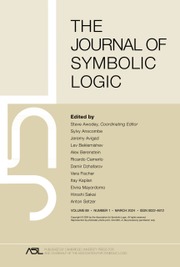No CrossRef data available.
Article contents
TORSION-FREE ABELIAN GROUPS OF FINITE RANK AND FIELDS OF FINITE TRANSCENDENCE DEGREE
Published online by Cambridge University Press: 13 February 2025
Abstract
Let  $\operatorname {TFAb}_r$ be the class of torsion-free abelian groups of rank r, and let
$\operatorname {TFAb}_r$ be the class of torsion-free abelian groups of rank r, and let  $\operatorname {FD}_r$ be the class of fields of characteristic
$\operatorname {FD}_r$ be the class of fields of characteristic  $0$ and transcendence degree r. We compare these classes using various notions. Considering the Scott complexity of the structures in the classes and the complexity of the isomorphism relations on the classes, the classes seem very similar. Hjorth and Thomas showed that the
$0$ and transcendence degree r. We compare these classes using various notions. Considering the Scott complexity of the structures in the classes and the complexity of the isomorphism relations on the classes, the classes seem very similar. Hjorth and Thomas showed that the  $\operatorname {TFAb}_r$ are strictly increasing under Borel reducibility. This is not so for the classes
$\operatorname {TFAb}_r$ are strictly increasing under Borel reducibility. This is not so for the classes  $\operatorname {FD}_r$. Thomas and Velickovic showed that for sufficiently large r, the classes
$\operatorname {FD}_r$. Thomas and Velickovic showed that for sufficiently large r, the classes  $\operatorname {FD}_r$ are equivalent under Borel reducibility. We try to compare the groups with the fields, using Borel reducibility, and also using some effective variants. We give functorial Turing computable embeddings of
$\operatorname {FD}_r$ are equivalent under Borel reducibility. We try to compare the groups with the fields, using Borel reducibility, and also using some effective variants. We give functorial Turing computable embeddings of  $\operatorname {TFAb}_r$ in
$\operatorname {TFAb}_r$ in  $\operatorname {FD}_r$, and of
$\operatorname {FD}_r$, and of  $\operatorname {FD}_r$ in
$\operatorname {FD}_r$ in  $\operatorname {FD}_{r+1}$. We show that under computable countable reducibility,
$\operatorname {FD}_{r+1}$. We show that under computable countable reducibility,  $\operatorname {TFAb}_1$ lies on top among the classes we are considering. In fact, under computable countable reducibility, isomorphism on
$\operatorname {TFAb}_1$ lies on top among the classes we are considering. In fact, under computable countable reducibility, isomorphism on  $\operatorname {TFAb}_1$ lies on top among equivalence relations that are effective
$\operatorname {TFAb}_1$ lies on top among equivalence relations that are effective  $\Sigma _3$.
$\Sigma _3$.
Information
- Type
- Article
- Information
- Copyright
- © The Author(s), 2025. Published by Cambridge University Press on behalf of The Association for Symbolic Logic


